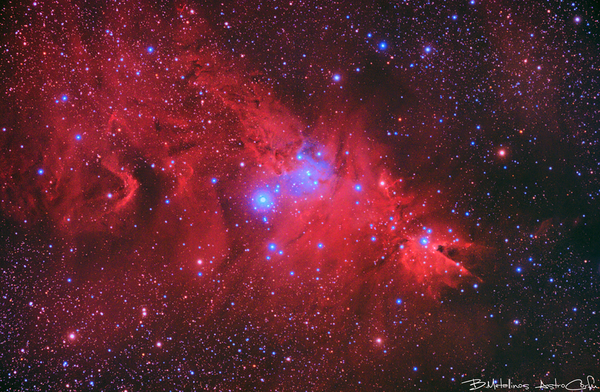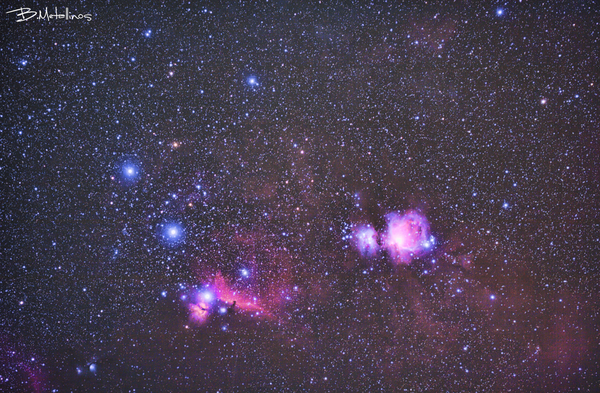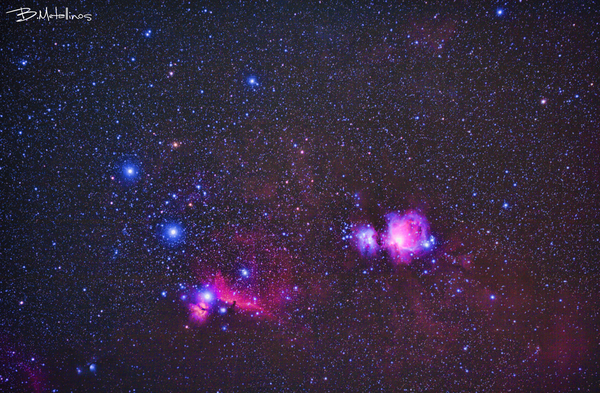-
Αναρτήσεις
12720 -
Εντάχθηκε
-
Τελευταία επίσκεψη
-
Ημέρες που κέρδισε
3
Τύπος περιεχομένου
Forum
Λήψεις
Ιστολόγια
Αστροημερολόγιο
Άρθρα
Αστροφωτογραφίες
Store
Αγγελίες
Όλα αναρτήθηκαν από Bi2L
-

Κρόνος και Ερμής λιγότερο από μισή μοίρα κοντά στο λυκαυγές
Bi2L δημοσίευσε ένα ημερολογιακό γεγονός σε Αστροημερολόγιο
Κρόνος και Ερμής λιγότερο από μισή μοίρα κοντά στο λυκαυγές -

Κρόνος, Ερμής και κομήτης C/2012 S1 (ISON) σε κοντά το ξημέρ
Bi2L δημοσίευσε ένα ημερολογιακό γεγονός σε Αστροημερολόγιο
Κρόνος, Ερμής και κομήτης C/2012 S1 (ISON) σε κοντά το ξημέρωμα -
Σελήνη και Δίας κοντά
-
Περιήλιο κομήτη 2P/Encke
-
Η Αφροδίτη πολύ κοντά στον σ Τοξότη
-

Ο Κομήτης C/2012 S1 (ISON) πολύ κοντά στο Στάχυ
Bi2L δημοσίευσε ένα ημερολογιακό γεγονός σε Αστροημερολόγιο
Ο Κομήτης C/2012 S1 (ISON) πολύ κοντά στο Στάχυ -
Ο Ερμής σε μέγιστη δυτική αποχή
-
Σελήνη κοντά στον Αλντεμπαράν
-
Μηνίσκος Σελήνης και Αφροδίτη κοντά
-

Διέλευση δύο σκιών δορυφόρων από το δίσκο του Δία
Bi2L δημοσίευσε ένα ημερολογιακό γεγονός σε Αστροημερολόγιο
Διέλευση δύο σκιών δορυφόρων από το δίσκο του Δία -

Υβριδική έκλειψη ηλίου, ορατή από την Ελλάδα ως μερική
Bi2L δημοσίευσε ένα ημερολογιακό γεγονός σε Αστροημερολόγιο
Υβριδική έκλειψη ηλίου, ορατή από την Ελλάδα ως μερική -

Μηνίσκος Σελήνης και Στάχυς σε απόσταση μισής μοίρας στο λυκ
Bi2L δημοσίευσε ένα ημερολογιακό γεγονός σε Αστροημερολόγιο
Μηνίσκος Σελήνης και Στάχυς σε απόσταση μισής μοίρας στο λυκαυγές -
Η Αφροδίτη σε μέγιστη ανατολική αποχή
-

Νεο Ελληνικο EPOD απ'τον Κωστα Εμμανουηλιδη
Bi2L απάντησε στην συζήτηση του/της cripto777 σε Αστροφωτογράφιση - Γενική συζήτηση
Μπράβο Κώστα, περιμένουμε τα υπόλοιπα http://epod.usra.edu/blog/2013/11/milky-way-and-zodiacal-light.html -
NGC 2264, Cone Nebula, Christmas Tree Cluster, η γούνα της αλεπούς, Χιονονιφάδα Observation Team of Astronomic Society of Corfu Μετα από πολλά προβλήματα με την Em200 αλλά και μπόλικη νέφωση κατά την διάρκεια της Νουμηνίας επιτέλους μας έκανε την χάρη και βγάλαμε μια Deepsky φωτογραφία, ελπίζω να σας αρέσει Το αντικείμενο 2264 του Νέου Γενικού Καταλόγου, βρίσκεται στον Αστερισμό του Μονόκερου σε απόσταση 800 parsecs ή 2600 έτη φωτός από τη Γη, το αντικείμενο NGC 2264 συμπεριλαμβάνει το σμήνος "Χριστουγεννιάτικο Δέντρο" και το Νεφέλωμα του Κώνου αλλά όχι το Νεφέλωμα της γούνας της αλεπούς και το σμήνος της Χιονονιφάδας αν και τα δύο τελευταία βρίσκονται στην ίδια περιοχή απλά δεν συμπεριλαμβάνονται επίσημα στον κατάλογο. Το Νεφέλωμα του Κώνου βρίσκεται στην δεξιά πλευρά της εικόνας και αν περιστρέψουμε την εικόνα 90° αριστερά τότε θα βρίσκεται στην κορυφή του Χριστουγεννιάτικου δέντρου, το φωτεινό αστέρι ακριβώς πάνω από τον κώνο είναι η κορυφή του δέντρου και το πολύ φωτεινό αστέρι στο κέντρο της εικόνας (S-Μον) είναι το κέντρο του κορμού του δέντρου. Το νεφέλωμα Snowflake είναι στη μέση και ξεχωρίζει απ'το Γαλαζωπό του χρώμα ενώ ακριβώς απο πάνω δεξιά του είναι το νεφέλωμα της γούνας της αλεπούς. Τηλεσκόπιο: Takahashi APO TOA130 790mm f/6.08 Στήριξη: Takahashi Em200-Temma2, Thesky6 Κάμερα: Canon eos 400D mod Φίλτρο: Astronomik EOS Clip CLS Διορθωτής/Μειωτής: TS PHOTOLINE 0,79x Reduce Οδήγηση: Finderscope, Qhy5, Phd Λήψεις/Εκθέσεις: 12X1800sec Iso800, Darks Λήψη: Astro Photography Tool - APT Επεξεργασία: Deepskystacker, Photoshop
-
-
From the album: Προσωπικό άμπουμ του/της Bi2L
Orion's Belt - Η ζώνη του Ωρίωνα, Messier42, Horsehead, Flame Στην Αστρονομία η ζώνη του Ωρίωνα αποτελείται από τρεις αστέρες του αστερισμού του Ωρίωνα. Πρόκειται για τους αστέρες δευτέρου βαθμού δ του Ωρίωνα, ε του Ωρίωνα, και ζ του Ωρίωνα, που φέρονται, ως ζωστήρας του μυθικού ήρωα, σε ευθεία γραμμή μέσα στο τετράπλευρο του αστερισμού και σχεδόν κατά μήκος προς τον ουράνιο ισημερινό. Οι αστέρες αυτοί είναι επίσης γνωστοί και με τα ονόματα "Τρεις Βασιλείς", "Τρεις Μάγοι", "Πήχυς", και "Ράβδος του Ααρών" ή "Ράβδος του Ιακώβ". Το 1827 το Πανεπιστήμιο της Λειψίας προκειμένου να τιμήσει τον Μέγα Ναπολέοντα ονόμασε τους αστέρες αυτούς "Ράβδο του Ναπολέοντα", πλην όμως η ονομασία αυτή δεν επεκράτησε. Επίσης, οι αστέρες είναι γνωστοί και με την ονομασία Τελαμών. Κείμενο Wikipedia http://en.wikipedia.org/wiki/Orion%27s_Belt Orion's Belt or the Belt of Orion is an asterism in the constellation Orion. It consists of the three bright stars Alnitak, Alnilam and Mintaka. Looking for Orion's Belt in the night sky is the easiest way to locate the constellation Orion in the sky. The stars are more or less evenly spaced in a straight line, and so can be visualized as the belt of the hunter's clothing. In the Northern hemisphere, they are best visible in the early night sky during the winter, in particular the month of January at around 9.00 pm Alnitak Alnitak is pronounced: ALL-nit-ahk. Orion is a constellation of its own, but its also held inside another constellation. Alnitak is a triple star system at the eastern end of Orion's belt, and is 736 light years from the earth. It has 100,000 times the luminosity of the sun. The primary (Alnitak A) is itself a close binary, comprising Alnitak Aa (a blue supergiant of spectral and luminosity type O9.7 Ibe, with an absolute magnitude of -5.25 and an apparent magnitude of 2.0) and Alnitak Ab (a blue dwarf of spectral and luminosity type O9V, with an absolute magnitude of about -3.0 and an apparent magnitude of about 4, discovered in 1998 [2]). Aa is estimated as being up to 28 times as massive as the sun, and to have a diameter 20 times greater.[3] It is the brightest star of class O in the night sky. Alnitak B is a 4th magnitude B-type star which orbits Alnitak A every 1500 years. A fourth star, 9th magnitude Alnitak C, has not been confirmed to be part of the Aa-Ab-B group, and may simply lie along the line of sight. The Alnitak system is bathed in the nebulosity of IC 434. Alnilam Alnilam (Epsilon Orionis) is approximately 1340 light years away from earth and shines with magnitude 1.70. Considering ultraviolet light Alnilam is 375,000 times more luminous than the Sun.[2] It is a large blue supergiant star in the constellation of Orion. Its Flamsteed designation is 46 Orionis. It is the 30th brightest star in the sky (the 4th brightest in Orion) and is a blue-white supergiant. Together with Mintaka and Alnitak, the three stars make up the belt of Orion, known by many names across many ancient cultures. Alnilam is the middle star. Since 1943, the spectrum of this star has served as one of the stable anchor points by which other stars are classified.[1] It is also one of the 57 stars used in celestial navigation. It is at its highest point in the sky around midnight on December 15. Alnilam's relatively simple spectrum has made it useful for studying the interstellar medium. Within the next million years, this star may turn into a red supergiant and explode as a supernova. It is surrounded by a molecular cloud, NGC 1990, which it brightens to make a reflection nebula. Its stellar winds may reach up to 2000 km/s, causing it to lose mass about 20 million times more rapidly than the Sun. Mintaka Pronounced MIN-ta-ka. Mintaka (Delta Orionis) is 915 light years away and shines with magnitude 2.21. Mintaka is 90,000 times more luminous than the Sun. Mintaka is a double star. Both stars orbit around each other every 5.73 days Canon eos 40D Full Spectra EF 100mm IS Usm L F2.8 iso400 70X180sec Deepskystacker, Photoshop -
-
Orion's Belt - Η ζώνη του Ωρίωνα, Messier42, Horsehead, Flame Στην Αστρονομία η ζώνη του Ωρίωνα αποτελείται από τρεις αστέρες του αστερισμού του Ωρίωνα. Πρόκειται για τους αστέρες δευτέρου βαθμού δ του Ωρίωνα, ε του Ωρίωνα, και ζ του Ωρίωνα, που φέρονται, ως ζωστήρας του μυθικού ήρωα, σε ευθεία γραμμή μέσα στο τετράπλευρο του αστερισμού και σχεδόν κατά μήκος προς τον ουράνιο ισημερινό. Οι αστέρες αυτοί είναι επίσης γνωστοί και με τα ονόματα "Τρεις Βασιλείς", "Τρεις Μάγοι", "Πήχυς", και "Ράβδος του Ααρών" ή "Ράβδος του Ιακώβ". Το 1827 το Πανεπιστήμιο της Λειψίας προκειμένου να τιμήσει τον Μέγα Ναπολέοντα ονόμασε τους αστέρες αυτούς "Ράβδο του Ναπολέοντα", πλην όμως η ονομασία αυτή δεν επεκράτησε. Επίσης, οι αστέρες είναι γνωστοί και με την ονομασία Τελαμών. Κείμενο Wikipedia http://en.wikipedia.org/wiki/Orion%27s_Belt Orion's Belt or the Belt of Orion is an asterism in the constellation Orion. It consists of the three bright stars Alnitak, Alnilam and Mintaka. Looking for Orion's Belt in the night sky is the easiest way to locate the constellation Orion in the sky. The stars are more or less evenly spaced in a straight line, and so can be visualized as the belt of the hunter's clothing. In the Northern hemisphere, they are best visible in the early night sky during the winter, in particular the month of January at around 9.00 pm Alnitak Alnitak is pronounced: ALL-nit-ahk. Orion is a constellation of its own, but its also held inside another constellation. Alnitak is a triple star system at the eastern end of Orion's belt, and is 736 light years from the earth. It has 100,000 times the luminosity of the sun. The primary (Alnitak A) is itself a close binary, comprising Alnitak Aa (a blue supergiant of spectral and luminosity type O9.7 Ibe, with an absolute magnitude of -5.25 and an apparent magnitude of 2.0) and Alnitak Ab (a blue dwarf of spectral and luminosity type O9V, with an absolute magnitude of about -3.0 and an apparent magnitude of about 4, discovered in 1998 [2]). Aa is estimated as being up to 28 times as massive as the sun, and to have a diameter 20 times greater.[3] It is the brightest star of class O in the night sky. Alnitak B is a 4th magnitude B-type star which orbits Alnitak A every 1500 years. A fourth star, 9th magnitude Alnitak C, has not been confirmed to be part of the Aa-Ab-B group, and may simply lie along the line of sight. The Alnitak system is bathed in the nebulosity of IC 434. Alnilam Alnilam (Epsilon Orionis) is approximately 1340 light years away from earth and shines with magnitude 1.70. Considering ultraviolet light Alnilam is 375,000 times more luminous than the Sun.[2] It is a large blue supergiant star in the constellation of Orion. Its Flamsteed designation is 46 Orionis. It is the 30th brightest star in the sky (the 4th brightest in Orion) and is a blue-white supergiant. Together with Mintaka and Alnitak, the three stars make up the belt of Orion, known by many names across many ancient cultures. Alnilam is the middle star. Since 1943, the spectrum of this star has served as one of the stable anchor points by which other stars are classified.[1] It is also one of the 57 stars used in celestial navigation. It is at its highest point in the sky around midnight on December 15. Alnilam's relatively simple spectrum has made it useful for studying the interstellar medium. Within the next million years, this star may turn into a red supergiant and explode as a supernova. It is surrounded by a molecular cloud, NGC 1990, which it brightens to make a reflection nebula. Its stellar winds may reach up to 2000 km/s, causing it to lose mass about 20 million times more rapidly than the Sun. Mintaka Pronounced MIN-ta-ka. Mintaka (Delta Orionis) is 915 light years away and shines with magnitude 2.21. Mintaka is 90,000 times more luminous than the Sun. Mintaka is a double star. Both stars orbit around each other every 5.73 days Canon eos 40D Full Spectra EF 100mm IS Usm L F2.8 iso400 70X180sec Deepskystacker, Photoshop




